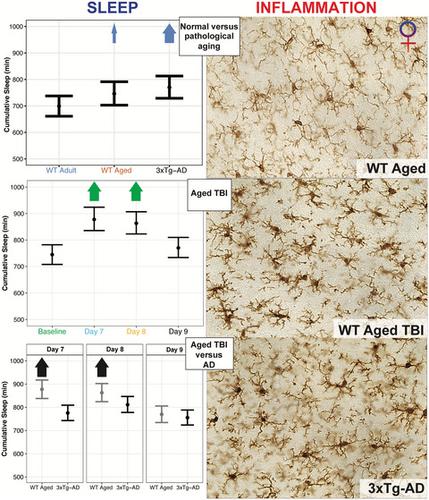当前位置:
X-MOL 学术
›
J. Neurosci. Res.
›
论文详情
Our official English website, www.x-mol.net, welcomes your feedback! (Note: you will need to create a separate account there.)
Experimental diffuse brain injury and a model of Alzheimer's disease exhibit disease‐specific changes in sleep and incongruous peripheral inflammation
Journal of Neuroscience Research ( IF 4.2 ) Pub Date : 2020-12-14 , DOI: 10.1002/jnr.24771 Maha Saber 1, 2 , Sean M Murphy 2 , Yerin Cho 1, 2 , Jonathan Lifshitz 1, 2, 3 , Rachel K Rowe 1, 2, 3
Journal of Neuroscience Research ( IF 4.2 ) Pub Date : 2020-12-14 , DOI: 10.1002/jnr.24771 Maha Saber 1, 2 , Sean M Murphy 2 , Yerin Cho 1, 2 , Jonathan Lifshitz 1, 2, 3 , Rachel K Rowe 1, 2, 3
Affiliation

|
Elderly populations (≥65 years old) have the highest risk of developing Alzheimer's disease (AD) and/or obtaining a traumatic brain injury (TBI). Using translational mouse models, we investigated sleep disturbances and inflammation associated with normal aging, TBI and aging, and AD. We hypothesized that aging results in marked changes in sleep compared with adult mice, and that TBI and aging would result in sleep and inflammation levels similar to AD mice. We used female 16‐month‐old wild‐type (WT Aged) and 3xTg‐AD mice, as well as a 2‐month‐old reference group (WT Adult), to evaluate sleep changes. WT Aged mice received diffuse TBI by midline fluid percussion, and blood was collected from both WT Aged (pre‐ and post‐TBI) and 3xTg‐AD mice to evaluate inflammation. Cognitive behavior was tested, and tissue was collected for histology. Bayesian generalized additive and mixed‐effects models were used for analyses. Both normal aging and AD led to increases in sleep compared with adult mice. WT Aged mice with TBI slept substantially more, with fragmented shorter bouts, than they did pre‐TBI and compared with AD mice. However, differences between WT Aged and 3xTg‐AD mice in immune cell populations and plasma cytokine levels were incongruous, cognitive deficits were similar, and cumulative sleep was not predictive of inflammation or behavior for either group. Our results suggest that in similarly aged individuals, TBI immediately induces more profound sleep alterations than in AD, although both diseases likely include cognitive impairments. Unique pathological sleep pathways may exist in elderly individuals who incur TBI compared with similarly aged individuals who have AD, which may warrant disease‐specific treatments in clinical settings.
中文翻译:

实验性弥漫性脑损伤和阿尔茨海默病模型表现出睡眠和不协调的外周炎症的疾病特异性变化
老年人群(≥65 岁)患阿尔茨海默病 (AD) 和/或创伤性脑损伤 (TBI) 的风险最高。使用平移小鼠模型,我们研究了与正常衰老、TBI 和衰老以及 AD 相关的睡眠障碍和炎症。我们假设与成年小鼠相比,衰老会导致睡眠显着变化,并且 TBI 和衰老会导致与 AD 小鼠相似的睡眠和炎症水平。我们使用 16 个月大的雌性野生型(WT Aged)和 3xTg-AD 小鼠以及 2 个月大的参考组(WT 成人)来评估睡眠变化。WT 老年小鼠通过中线液体敲击接受弥漫性 TBI,并从 WT 老年(TBI 前和 TBI 后)和 3xTg-AD 小鼠收集血液以评估炎症。测试了认知行为,并收集了组织用于组织学。贝叶斯广义加性和混合效应模型用于分析。与成年小鼠相比,正常衰老和 AD 都会导致睡眠增加。与 TBI 前和与 AD 小鼠相比,患有 TBI 的 WT 老年小鼠睡眠时间明显更多,发作时间更短。然而,WT Aged 和 3xTg-AD 小鼠在免疫细胞群和血浆细胞因子水平方面的差异是不协调的,认知缺陷相似,并且累积睡眠不能预测任何一组的炎症或行为。我们的研究结果表明,在年龄相仿的个体中,TBI 会立即引起比 AD 更严重的睡眠改变,尽管这两种疾病都可能包括认知障碍。与患有 AD 的同龄个体相比,患有 TBI 的老年人可能存在独特的病理性睡眠途径,
更新日期:2021-02-21
中文翻译:

实验性弥漫性脑损伤和阿尔茨海默病模型表现出睡眠和不协调的外周炎症的疾病特异性变化
老年人群(≥65 岁)患阿尔茨海默病 (AD) 和/或创伤性脑损伤 (TBI) 的风险最高。使用平移小鼠模型,我们研究了与正常衰老、TBI 和衰老以及 AD 相关的睡眠障碍和炎症。我们假设与成年小鼠相比,衰老会导致睡眠显着变化,并且 TBI 和衰老会导致与 AD 小鼠相似的睡眠和炎症水平。我们使用 16 个月大的雌性野生型(WT Aged)和 3xTg-AD 小鼠以及 2 个月大的参考组(WT 成人)来评估睡眠变化。WT 老年小鼠通过中线液体敲击接受弥漫性 TBI,并从 WT 老年(TBI 前和 TBI 后)和 3xTg-AD 小鼠收集血液以评估炎症。测试了认知行为,并收集了组织用于组织学。贝叶斯广义加性和混合效应模型用于分析。与成年小鼠相比,正常衰老和 AD 都会导致睡眠增加。与 TBI 前和与 AD 小鼠相比,患有 TBI 的 WT 老年小鼠睡眠时间明显更多,发作时间更短。然而,WT Aged 和 3xTg-AD 小鼠在免疫细胞群和血浆细胞因子水平方面的差异是不协调的,认知缺陷相似,并且累积睡眠不能预测任何一组的炎症或行为。我们的研究结果表明,在年龄相仿的个体中,TBI 会立即引起比 AD 更严重的睡眠改变,尽管这两种疾病都可能包括认知障碍。与患有 AD 的同龄个体相比,患有 TBI 的老年人可能存在独特的病理性睡眠途径,



























 京公网安备 11010802027423号
京公网安备 11010802027423号